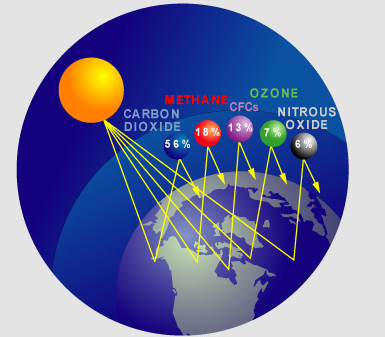"Long-term Climate Change:"
Human Effects on Climate
climate is changing across our planet, largely as a result of human activities.
These are the unapproved words of Working Group 1: for the Fifth Assessment Report of the IPCC that was released in draft form as of 7 June 2013.
Human activities are continuing to affect the Earth’s energy budget by changing the emissions and resulting atmospheric concentrations of radiatively important gases and aerosols and by changing land surface properties. Previous assessments have already shown through multiple lines of evidence that the climate is changing across our planet, largely as a result of human activities. The most compelling evidence of climate change derives from observations of the atmosphere, land, oceans, and cryosphere.
Unequivocal evidence from in situ observations and ice core records shows that the atmospheric concentrations of important greenhouse gases such as carbon dioxide, methane, and nitrous oxides have increased over the last few centuries.
Projections, Commitments and Irreversibility;
"Cumulative emissions of CO2 largely determine global mean surface warming by the late 21st century and beyond (see Figure SPM.10). Most aspects of climate change will persist for many centuries even if emissions of CO2 are stopped. This represents a substantial multi-century climate change commitment created by past, present and future emissions of CO2. {12.5}"
Page SPM-19.
So what do we do given this prognosis?
"Limiting the warming caused by anthropogenic CO2 emissions alone with a probability of >33%, >50%, and >66% to less than 2°C since the period 1861–188022, will require cumulative CO2 emissions from all anthropogenic sources to stay between 0 and about 1560 GtC, 0 and about 1210 GtC, and 0 and about 1000 GtC since that period respectively23."
1) "A lower warming target, or a higher likelihood of remaining below a specific warming target, will require lower cumulative CO2 emissions."
2) "A large fraction of anthropogenic climate change resulting from CO2 emissions is irreversible on a multi-century to millennial time scale, except in the case of a large net removal of CO2 from the atmosphere over a sustained period. Surface temperatures will remain approximately constant at elevated levels for many centuries after a complete cessation of net anthropogenic CO2 emissions. Due to the long time scales of heat transfer from the ocean surface to depth, ocean warming will continue for centuries. Depending on the scenario, about 15 to 40% of emitted CO2 will remain in the atmosphere longer than 1,000 years. {Box 6.1, 12.4,12.5}"
3) "It is virtually certain that global mean sea level rise will continue beyond 2100, with sea level rise due to thermal expansion to continue for many centuries. The few available model results that go beyond 2100 indicate global mean sea level rise above the pre-industrial level by 2300 to be less than 1 m for a radiative forcing that corresponds to CO2 concentrations that peak and decline and remain below 500 ppm, as in the scenario RCP2.6."
page SPM-20.
We are currently at 400 ppm with respect to CO2 concentrations in the atmosphere. There is debate about what precisely is the threshold for carbon dioxide and other heat trapping gases and therefore when the earth will pass that tipping point or series of different triggers that cause irreversible conditions in both oceans and atmosphere.
New York Times commentary:
"The fifth I.P.C.C. report finds that the atmosphere can accommodate only another one trillion tons of carbon dioxide emissions to the end of the century if the rise in the global temperature is to be limited to 2 degrees Celsius, or 3.6 degrees Fahrenheit."
Indian negotiator says Climate Change talks a partial success. November 25, 2013, 5:51 am. India’s Negotiator Says Climate Treaty Talks ‘Partial Success,’ By BETWA SHARMA
Source
Details [verbatim] from the Summary for Policy Makers of AR5 from the:
Intergovernmental Panel on Climate Change, Working Group One, Fifth Assessment Report–AR5, 27 September 2013.


